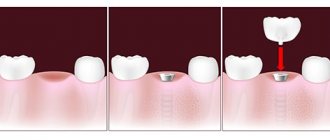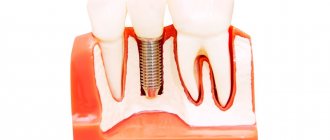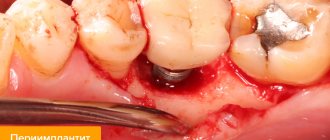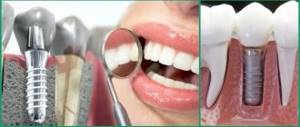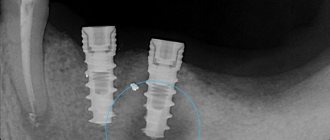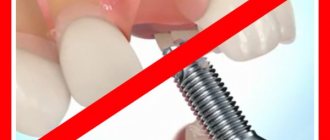Stages of the implantation procedure
In modern times, implantation is carried out in several stages. This is more preferable for dentists and patients. The procedure is divided into the following stages:
- Initially, the patient is pre-consulted to identify contraindications and indications for the procedure. Dental, social and somatic factors may serve as contraindications.
- Then a detailed diagnosis is made using computed tomography and stereolithography. At this stage, the entire procedure is planned.
- Treatment measures are discussed with the client. He is provided with detailed information about the procedure and an agreement is concluded between the dental clinic and the patient.
- Dental therapists, orthodontists and periodontists prepare the workplace for the procedure.
- During the procedure, bone tissue may or may not be built up, and alveolar ridges and jaw bones may also be reconstructed. If necessary, they can make a somatic correction. Indications for the use of correction are the presence of diabetes mellitus and other diseases.
- At this stage, an implant is installed, defects are removed and the functions of the musculoskeletal system are restored.
- As a result of the procedure, the patient’s condition is monitored and a preventive examination is performed.
What guarantees does the patient receive?
No matter what dentistry website you visit, there will be a lot of promises there. You can get confused. Or see the words “lifetime warranty” and decide – this is what you need. There is no need to rush, because there are different guarantees.
Implant warranty
It is she who will most likely end up with a lifelong sentence. All well-known manufacturers provide a lifetime warranty on their implants. Knowing that the pin will not rust, fall apart or oxidize is certainly nice. What happens if the implant does not take root? There are clinics that undertake reinstallation of the implant in case of rejection. Implantation is a complex, multi-stage process and I would like to be sure of the quality at all stages
Doctors' work guarantee
Here everything is not so rosy. Only dental centers that are confident in the professionalism of their implantologists and value their reputation take on such obligations. Only highly qualified doctors can deliver high-quality implants. Typically, warranties for doctors' work are not as long as for products. On average, this is 1, maximum 2 years. It is important to understand that the clinic bears responsibility under the contract in case of trouble. A large center will be in its place in 2 or 3 years, but a tiny dentistry can close at any time. Along with it, warranty obligations will disappear.
Methods for installing a dental implant
There are different types of dental implants:
- one-piece;
- two-part;
- classic root-shaped;
- basal;
- compression and others.
The choice of implant model depends on the method of its installation. There are several ways to install dental elements:
Flap method of implant installation
The flap technique for installing dental implants is carried out in several stages:
- At the beginning of the procedure, it is necessary to numb the place where the dental element is installed, that is, anesthesia is performed.
- Then the gums are treated with an antiseptic.
- At this stage, incisions are made on the gum - one is made along the gum, the other two across. This is done in order to form a kind of “flap”. It is thanks to this flap that you can approach the bone tissues of the jaw.
- A hole for an implant of a certain size is made in the bone tissue using special dental instruments.
- It is then screwed into the bone tissue.
- Sutures are placed on the gum, restoring it to its previous condition.
After this method of installing dental elements, it is recommended to monitor your food intake for one or two weeks and consume solid foods in minimal quantities.
After the procedure, some complications may occur. This may include bleeding from the wound, pain in the gums and teeth, the stitches may come apart, which will lead to infections, the tissue around the implant will become inflamed and the structure will be rejected.
To avoid all these processes, it is recommended that after carrying out the procedure using this method, if any undesirable processes are detected, immediately contact a specialist.
The positive aspects of installing dental elements using this method are the following:
- This method has been used for quite a long time.
- Possible complications are minimized because this technique has been used in practice in the most complex and less common cases;
- The procedure using this technique is painless because the patient does not feel anything during the surgical procedure, thanks to anesthesia.
- The implant is practically invisible, which creates an aesthetically pleasing smile. The gums remain as smooth and beautiful.
Minimally invasive (transgingival) method of implant installation
This method of installing dental elements is considered quite fast and without damaging the tissue. This technique uses one-piece dental implants that are screwed into the bone tissue directly through the gums.
During the procedure using this method, no incisions are made, that is, no surgical intervention is required. The transgingival procedure is performed in several stages:
- First, the site where the dental element is installed is anesthetized.
- Then a hole is created and a section of gum that corresponds to the size of the implant is removed. There is virtually no bleeding during the creation of the hole.
- Subsequently, the implant is inserted. The process of fusion of bone tissue and implant begins immediately after its installation. A few months later, crowns or dentures are installed.
The positive aspects of using this technique are the following:
- The duration of the operation is short.
- The recovery period is also minimal.
- There are no unpleasant sensations after the operation.
- There is no chance of tissue infection.
- There is no chance of implant rejection.
- No surgery required.
- No bleeding during surgery.
Lateral implantation technique
This technique is used quite rarely, since there is a possibility of implant rejection by the gums and bone tissues. This method is the fastest, since the crown is attached almost immediately after installation of the implant. This technique allows you to preserve the volume of bone tissue in the area of the extracted tooth, as well as the volume and contour of the gums, which is very important for obtaining good aesthetics of the gingival margin around the implant. The procedure for this method is performed in several stages:
- First, the first thing to do is numb the place where the dental element is installed.
- A small puncture is then made in the bone tissue to place the dental implant. It must match the size of the dental element.
- Lateral implants are inserted from the side of the jaw.
- After installing the lateral implant, a temporary crown is installed, thanks to which there will be no problems during chewing.
- The permanent prosthesis is installed after its manufacture.
The positive aspects of using this technique in practice are the following:
- Treatment is carried out as quickly as possible.
- This procedure can be performed on patients with a low pain threshold without using anesthesia at all.
- During the operation, the patient does not experience discomfort.
- Treatment can be carried out with a small amount of bone tissue.
- Possibility of installing an implant on the day of tooth extraction.
- Chewing function is restored quite quickly.
- The patient receives virtually no radiation exposure, since X-rays are taken in extremely rare cases.
The one-step implantation method is also quite fast. The dental element is installed almost immediately after tooth extraction. The procedure for this method is carried out in several stages:
- First, an image is taken to make a temporary crown.
- Then a hole is made in the place of the removed tooth.
- An implant is inserted into the hole made. With this method, one-piece and two-piece implants can be installed, depending on the condition of the bone tissue and the health of the patient.
- After installing the dental element, a temporary crown is installed, the permanent prosthesis is installed after complete healing of the structure.
Before carrying out this procedure, the patient’s oral cavity is examined to determine the presence of caries or defects. This method can be used in the following cases:
- If there is a need to remove a severely damaged tooth.
- In case of severe tooth trauma with deep penetration under the gum tissue.
- If it is not possible to install dentures in place of the extracted tooth.
- For urgent restoration of anterior teeth.
- For diseases of the gums and teeth, when a tooth needs to be removed.
To carry out this operation, certain requirements must be met:
- There should be no large-scale destruction of the dental bone tissue.
- There should be healthy gum soft tissue around the extracted tooth.
- There must be the required amount of bone tissue.
- Inflammatory processes should not be present on the upper part of the root of the extracted tooth.
- The partitions between the roots must be preserved, provided that the extracted tooth is multi-rooted.
- There should be no atrophic changes in bone tissue.
There are also contraindications, which include:
- Allergic reactions to painkillers.
- Periodontal disease, periodontitis, osteoporosis.
- When immunity is reduced.
- Blood diseases.
- Presence of psychological illnesses.
- If you have cancer.
- For AIDS, sexually transmitted diseases, etc.
The positive aspects of using this technique in practice are the following:
- Short treatment period.
- Minimum indications of injury hazard.
- Minimum load readings on the installed prosthesis.
- There is a short recovery time and a minimal incidence of complications.
- The cost of dental implantation is low, the procedure is considered the least expensive (you can find out how much it costs by scheduling a consultation with a specialist).
- Long term use of implants. Such dental elements last for more than twenty years.
- The aesthetic appearance of the tooth is restored and, accordingly, a healthy smile.
- It is one of the most comfortable procedures, as it is painless and without discomfort.
- Natural gum contours are preserved.
- There are no gum incisions.
- Anesthetics are used in minimal quantities.
The one-step technique can be used both with partial and complete absence of teeth.
Our clinic staff create a comfortable environment for patients awaiting implantation. Well-coordinated, professional work of the team, for whom dentistry is not a job, but a vocation, will bring satisfaction to every client.
Implantation with laser
This method of implantation is the most advanced and technologically advanced. The operation is carried out practically, like the classic procedure, but instead of a scalpel, a laser is used to cut the gums. The percentage of engraftment is the highest and reaches almost 100 percent. Laser technology is used in the following situations:
- If the gum is cut and the implant is not installed immediately after healing.
- If the mucous membrane is re-opened, that is, with two-stage implantation.
- When the gum restoration process is carried out.
Implantation using a laser is carried out in several stages:
- First, preparation is carried out, during which the weight of the future tooth is calculated. This is necessary in order to understand what kind of load the gums will experience. If the dentist believes that there may not be enough bone tissue to perform the operation, then a sinus lift is performed (bone tissue is built up).
- Then the implant is inserted. But before this, a small incision is made using a laser; it is into this that the dental element will be inserted. It is implemented using high-tech and sensitive equipment - a physical dispensary. After implantation, sutures are placed on the laser-cut gum. Then a temporary crown is installed.
- Next comes the recovery process. Depending on the characteristics of the human body, this process can take from two to six months. During this time, the dental element must grow together and become accustomed to the bone tissue.
- After the implant has completely taken root, the second stage of laser implantation is carried out. Using a laser beam, the gums in the healed area are opened and a permanent crown is installed. It can be made of metal ceramics, metal-free ceramics, zirconium and titanium.
The main positive aspects of using this method are the following:
- Bleeding during the procedure is almost completely absent, since the gums are cut not with a scalpel, but with a laser beam. The laser beam instantly burns through the blood vessels. Due to the fact that there is no bleeding, there is no likelihood of inflammatory processes.
- The incision is made with a minimum length, on average it is made one centimeter long for each extracted tooth. The bone tissue is evaporated, so there is virtually no damage. The procedure is considered virtually non-traumatic, since this indicator is minimal. The tissues are restored and healed quite quickly. After installing a permanent prosthesis, you can return to your normal lifestyle and eat all foods.
- This operation using a laser takes a minimal amount of time. Within half an hour, the dentist makes an incision in the gum, implants a dental element and sutures the cut gum tissue.
- The procedure is completely sterile, since the laser beam has bactericidal properties.
- Side effects are practically absent completely. When using a scalpel, the dentist cannot guarantee that there will be no ingress of metallic dust. Metal particles can react with the surface of the implant, become electrified, and thus the patient will experience uncomfortable sensations. With the laser cutting method, this possibility is impossible.
- Anesthesia is used in minimal doses. Due to the minimal risk of injury and pain, a minimal amount of anesthetic is used to numb the incision site. In addition, it reduces the burden of drugs on the human body.
- Lack of psychological discomfort. From a psychological point of view, this operation is much easier, since it is not associated with bleeding gums. From the patient's point of view, cutting with a laser beam is less traumatic.
- The period of use of the implant is almost lifelong. The dental element is attached to the jaw very firmly, practically like a healthy tooth, therefore the period of use of the implant is very long.
The indications for the use of this laser method are practically no different from the indications for traditional implantation with a scalpel. An implant can be implanted using this method in any age category.
Implantologists
Most importantly, make sure that the implantologist is not a visiting specialist, but is part of the clinic’s staff. If a doctor is here today and there tomorrow, it will be difficult for you to get an appointment, and simply track his movements from clinic to clinic. In addition, visiting consultants are little concerned about the prestige of the dental center; they do not have close connections with doctors from other departments and technicians.
Education also plays a role. Not only the basic ones received many years ago, but constantly updated. Is the doctor certified to work with a specific brand? How long has it been since she took courses and attended trainings? Implantology is akin to programming - you get distracted for a while and that’s it, you can’t catch up. Simply placing a dental implant is not enough these days; you need to use current techniques with a high percentage of engraftment.
Non-surgical dental implantation
Dental implantation in dentistry can be carried out using various methods. The methods for performing this operation were described above. Non-surgical methods for installing a dental element are express methods, which include lateral, one-stage and others.
This non-surgical method is also called one-stage, seamless, with minimal risk of injury. With this technology, tissues are practically not injured. In this case, there is no need to build up bone tissue and the stress on the gums and healthy teeth is minimal.
Express methods include the following:
- Instant installation of implants. In this case, the dental element is installed immediately after the diseased tooth is removed.
- Implantation with immediate loading is the main express technology. In this case, one-piece structures are used. They are fixed with minimal traumatic risk.
- Mini-implantation involves the use of small-sized implants. They are auxiliary fixators of removable dentures. This is necessary in order to prevent them from slipping out of the mouth and making them more comfortable to wear.
In modern times, one of the most popular and in demand is implantation with instant loading.
Types of implant-supported dentures
Single crowns, bridges, as well as full and partial prosthetic structures are installed on implants. The latter option can be removable (the patient removes such a prosthesis himself) or conditionally removable (it is removed by a doctor if necessary). So, if the patient is completely edentulous, then a conditionally removable dental prosthesis can be made for him, which will be fixed to 2, 4 or 6 implanted implants. This is a revolutionary method of dental prosthetics, which completely returns the functionality of the dentofacial apparatus, and the aesthetics of appearance to the person.
Non-surgical installation of implants
If the patient chooses implantation with immediate loading, he saves himself from surgical intervention, which occurs in several situations:
- When it is necessary to adjust the volume of bone tissue. In such a situation, dental implants have a distinctive feature - they can be installed even where there is a small amount of bone tissue. The shape and thread of the dental elements allow for painless installation. There is no need to build up bone tissue with this method of tooth restoration. To fix the dental element, the bone shell of the jaw is used, as well as the basal layer. Neither the tunica nor the basal layer will be reduced even in situations of severe atrophy. They will remain just as strong and firmly fix the implant.
- When it is necessary to implant a dental element into bone tissue. If conventional implants are used, then a rather complex operation must be performed. It is necessary to cut and peel off the gum, then drill a hole of a certain size in the bone and then install the dental element. After the structure is fixed, the gum is sutured. After the implant has healed, the gum is cut again and a crown is installed. When using one-piece dental structures, such moments can be avoided. No incision is made, just a puncture is made, into which the dental product is subsequently screwed into the bone tissue. The risk of injury is reduced to a minimum.
Thus, we can conclude that non-surgical implantation exists. Such operations are carried out using immediate loading. The method serves as express prosthetics. After the implant is installed, impressions of the tooth are taken to create permanent dentures. They are installed after two or three days.
With this method of restoring teeth, the load on the teeth will be distributed evenly, this is a feature of the technology. Bone cells will evenly receive the necessary nutrients for growth. The tissue regenerates quite quickly, which leads to the natural functioning of the oral cavity.
Licenses and certificates
A clinic where an implant can be installed must have a license for this type of activity. Certificates confirming partnerships with supplier companies protect against counterfeiting. Doctors are awarded certificates upon completion of training on working with a specific brand. Typically, dental centers are proud of their achievements and display documents for public viewing. If certificates and licenses are not visible, something is wrong with the clinic.
Implantation immediately after tooth extraction
Based on statistics, surgery on the lower jaw is more successful than installing implants on the lower jaw. This factor depends on different bone densities.
As a result of an immediate operation, where there is an immediate load on the dental element, the possibility of rejection of the implant from the bone tissue increases. In many cases, complications can arise due to the characteristics of the human body to foreign elements. In principle, the percentage of complications from the instant technique to other implantation methods is almost the same.
The main advantage of using this technique is that the implant can be installed immediately after removing the diseased tooth. If there is a chronic infectious focus on the upper part of the tooth root that will be removed, then this is an indicator of the risk of complications in a minimal percentage.
But this also does not serve as a contraindication to the procedure. If the patient is a smoker, then dentists do not recommend using this method of dental restoration. Also, such an operation cannot be performed if you have osteoporosis or poor oral hygiene.
If the patient does not want to waste time going to the dental clinic, then with this method they can remove the diseased tooth and immediately install an implant. For many, this is an undeniable advantage.
Important : It must be taken into account that when carrying out immediate dental implantation, in many cases it is necessary to plant bone tissue, and a barrier membrane can also be used. It is necessary in order to regenerate bone. The use of a fit is necessary in situations where the diameter of the dental element is smaller than the size of the puncture at the site of the extracted tooth. That is, between the dental element and one of the bone walls there will be an empty space that needs to be filled with bone material.
Toilet bone wound
Curettage of a bone wound is indicated only if granulating periodontitis is detected or the presence of a fibrous formation or granuloma at the apex of the tooth root. Use a curettage spoon with extreme caution. It is necessary to especially carefully evacuate the mucous membrane that has grown into the root cavity due to the inflammatory process. Granulations, if they are found in the inner surface of the gum edge, are also thoroughly cleaned. The hole must be disinfected. For disinfection, an antiseptic solution of gentamicin, chlorhexidine or saline solution (9%) is used.
The choice of implant size occurs after measuring the root diameter at different levels. Implant selection criteria (see photo 12):
- the length of the implant should be 2-5 mm longer than the hole;
- width - 1-2 mm larger than the hole.
Contraindications for implantation
Before performing an implantation procedure, the dentist must check the patient for possible contraindications. They are divided into several varieties.
Absolutes include the following:
- blood diseases;
- if there are malignant tumors;
- with immune pathology;
- if there are diseases of the central nervous system;
- if bisphosphonates are taken orally;
- in the presence of lupus erythematosus, rheumatoid arthritis, rheumatism, scleroderma;
- if you have tuberculosis;
- if there is recurrent stomatitis or pemphigus;
- if the function of the masticatory muscles is impaired;
- diabetics.
Relative contraindications include the following:
- Lack of oral sanitation.
- Poor oral hygiene (this is a good reason to prescribe removable dentures).
- For gingivitis.
- If there is marginal periodontitis.
- For pathological bites.
- For diseases of the temporomandibular joint.
- If there is severe atrophy or damage to bone tissue.
- If the patient smokes, drinks alcohol and drugs.
- When pregnant.
General contraindications consist of the following:
- Surgical reasons for refraining from any intervention.
- Contraindications to pain medications (negative tolerance to anesthesia).
- Certain somatic diseases that may be affected by the procedure (these include endocarditis and other heart diseases, rheumatism, etc.).
- Certain treatment methods can have an impact on the regeneration and preservation of the dental element after installation, on the tissue surrounding the dental element (if various types of depressants, anticoagulants, cytostatics and other agents are used).
- Diseases of the central nervous system.
- Distress syndrome (severe and prolonged stress, which is caused by all sorts of reasons).
- If there is exhaustion of the body.
- Poor oral hygiene (this is a good reason to prescribe removable dentures).
Local contraindications consist of the following:
- unsatisfactory tendency to oral hygiene;
- insufficient presence of bone tissue or its inappropriate structure;
- unsatisfactory distance to the maxillary and nasal sinuses.
Temporary contraindications include the following:
- acute diseases;
- rehabilitation and health stages;
- pregnant condition;
- addiction;
- condition after irradiation (the implantation procedure can be done after a year).
Complications following dental implantation
The use of modern implantation methods and high-quality dental products has made it possible to increase the popularity of this method over the previous twenty years. On average, the survival rate of dental elements over a period of 7-10 years is currently at almost one hundred percent success level. Moreover, success rates in the lower jaw are higher than in the upper jaw. This depends on the fact that the lower jaw bone is the densest.
To conclude, rejection of dental elements is not common, and the main reason for patient dissatisfaction is the deterioration of the aesthetic appearance where the gums are adjacent to the dental element. At the initial stage, it may look like a not very noticeable cyanosis of the gums, which will increase over time. Over time, gum recession may occur, that is, the neck of the dental element may be exposed.
This all occurs due to bone resorption near the neck of the dental element, as a result of which the metal part of it, which is deprived of bone tissue, begins to be visible through the gums, which gives a bluish appearance. The subsequent decrease in bone level results in loss of bone support and a reduction in bone level following the bone. Gum recession appears.
Based on practice, the occurrence of bone resorption and recession is only caused by errors and shortcomings of the treating dentist. The most common mistakes are:
- There is a thin bone wall (less than two millimeters) on the side of the front surface of the dental element, and the dentist, observing this, did not replant the bone, which leads to resorption of the upper part of this bone wall.
- Thin gum (two millimeters or less) on the jaw crest of the alveolar process, which does not allow the formation of the required volume of soft tissue near the dental element, and the dentist, observing this, did not increase the thickness of the gum. This could be done by transplanting a small flap of mucous membrane from the palate.
- Small distances (less than three millimeters) that separate the lateral surfaces of the dental element from the adjacent teeth or other dental elements, which leads to resorption of the lateral bone septa and a decrease in the level of interdental papillae.
In addition, there are other reasons, so you need to contact a competent specialist.
First meeting
The clinical examination begins with questioning the patient. Complaints, medical history, duration and cause of tooth damage are clarified. The patient’s past illnesses and surgical interventions, allergy status, bad habits and other life circumstances are established. Particular attention is paid to determining psycho-emotional status. The latter includes the identification and correction of asthenic, anxious, hypochondriacal and hysterical types of reaction.
The study of dental status begins with an external examination of the face, the condition of the oral mucosa: color, moisture, presence of bleeding, desquamation of the epithelium, ulcers, atrophic or hyperplastic processes. The depth of the periodontal pockets and the manifestation of discharge from them are determined. The presence of hard dental plaque and soft plaque is detected.
A special probe is used to determine the thickness and type of mucous membrane and gum attachment. A dental examination includes the identification of caries and its complications, non-carious lesions of hard tissues, assessment of the stability of the teeth, their relative position, as well as the type of bite. The condition of the tongue, the function of the salivary glands, the degree of mouth opening, and the severity of fatty tissue in soft tissues are checked. A complete sanitation of the oral cavity is carried out and the patient is trained in hygienic skills for oral care.
Is implantation technology right for you?
Dentists at the Presidential clinics take a responsible approach to various operations, including implantation. Our main goal is to achieve a completely flawless, comfortable and aesthetic result for the patient, which will serve as an exact copy of a natural tooth. We carry out implantation when we are one hundred percent sure of the effectiveness of the result.
Before the operation, the patient is consulted and a contract is drawn up. This stage is focused on a correct assessment of the prospects and the very possibility of implantation in each specific case.
During the consultation, the specialist carefully examines the condition of existing teeth and gums, assesses the density and volume of bone tissue. For accurate results, radiography is used, which displays the features of the bone structure in the place where dental elements will be installed.
Only based on the results of the examination, the specialist decides:
- is it possible to carry out implantation;
- what procedures need to be carried out before surgery;
- how long will the entire procedure last?
- total cost of services provided.
In various situations, dental implantation can be done only after augmentation of jaw bone tissue, gum tissue grafting or sinus lifting. Such operations in dental clinics are performed by specialized employees, and their cost is negotiated immediately after the consultation.
Also, in specific situations, you can do alternative implantation, which uses mini-implants made of titanium. Our dental network will try to do everything possible to return you to a healthy smile and your old lifestyle, freeing you from the problems associated with insufficient natural dentition.
Get a consultation
We will answer all your questions before visiting the clinic!
+7
Online registration
Content
hide
1 What is a surgical guide for dental implantation?
2 The key to accurate implant placement is a surgical template
3 The need to use surgical guides
4 In what cases is a navigation template used?
5 Making a surgical template for dental implantation
6 Materials used in the manufacture of a surgical template
7 Types of surgical templates for dental implantation
8 Advantages and disadvantages of navigation templates
9 Price of a surgical template at the Implantmaster clinic
10 Myths about using a surgical navigation template
How to choose a clinic for dental implantation in Moscow?
One of the ways to choose a clinic is through reviews of friends who have already visited it. If no one you know has undergone implantation, then you should consider the following factors:
- Workload of a specialist. When the workload is heavy, the specialist inspires more confidence.
- It is worth finding out information about whether he is a full-time employee or rents an office. Working on a regular basis will generate more trust.
- Equipped with equipment, availability of necessary equipment.
Our clinics employ highly qualified and professional dentists with extensive experience in this field, with certain knowledge, skills and abilities. The work uses modern technological ceramic structures and metal ceramics, as well as the latest methods and treatment systems.
We guarantee correct and most accurate diagnostics using high-precision equipment. Many of our Presidential dental clinics have Russia’s first three-dimensional dental computed tomograph GALILEOS from the manufacturing company Sirona.
Our professional specialists try to create a comfortable environment for any patient so that the implantation procedure is as comfortable as possible. The team works harmoniously and at a high professional level, and the cost of a dental implant will pleasantly surprise you.
see also
- Tooth extraction
- Teeth whitening
- Bite correction
- Dental prosthetics
In the online store Stomatorg you can buy everything you need for implantology
It should be noted that implantation does not forgive even minimal savings. All components are important here, from accurate diagnostics to the availability of high-quality consumables and tools. Without special and reliable equipment, even the most competent dentist will not be able to perform his work at the highest level. Our online store Stomatorg offers you a wide range of products from such well-known manufacturers as Anthogyr
,
Asa dental
,
KaVo
,
Kasios
,
Resorba
at affordable and quite reasonable prices.
Our company presents products for implantology that guarantee a long service life. All instruments and consumables presented in the online store have been repeatedly tested by professional dental clinics during their work and are in demand in world dentistry.
Implant placement is a procedure that involves inserting a foreign body into the patient's bone. Therefore, it is important that the implants take root, serving the patient for a long time, without creating even minimal discomfort. Naturally, such work is a complex process. Here, not only the doctor’s experience and diagnosis of the problem, but also the availability of special tools play a significant role. We offer you: abutments, an orthopedic set, a physiotherapy clinic, bone material and much more, which will ensure an effective result and the provision of prompt, safe and high-quality services - dental implantation.
The lack of necessary tools and technical problems can create all sorts of complications and errors. To avoid such problems, it is very important to purchase high-quality components that facilitate effective and quick implantation. When purchasing tools and consumables, pay attention to the manufacturer; it is best to give preference to trusted companies, such as Antogir. From us you can buy tools and materials that meet all norms and standards, in accordance with your needs and preferences. Experienced managers will help you make the right choice by providing the maximum information about the products you are interested in. Also, our online store differs from competitors - affordable prices. Our product is purchased by a considerable number of dental clinics that care about their clients and try to provide high-quality services.
Our company offers a large selection of high-quality dental instruments and consumables for implantology: updated Lectra New furnace
,
hydraulic press for crimping cuvettes PI.88.00
,
wax refiner DIPPY NT light
,
milling machine A2
,
grinding motor BIP.2.00
,
set of burs for therapy Composite Kit Blister
,
surgical set Axiom
and much more. All products meet the highest requirements of modern dentistry. Our consultants will be able to provide you with qualified assistance and advice in the selection and purchase of dental equipment, tools, and materials that will allow you to equip your dental clinic with everything necessary and perform work efficiently and professionally.
The products of our online store are used in dentistry and have managed to confidently occupy the highest positions in the dentistry market, thanks to the trust and recognition of not only experienced doctors, but also clients who have received an amazing effect as a result. That's why you can trust us.
All company products have the necessary quality certificates. Using it, you will be sure that the implants will be able to take root and serve the person for many years. Naturally, to carry out a procedure such as implantation, special tools and consumables are required, which are intended for preparing the bone bed, installing the implant and all its components. When selecting such auxiliary items, you should be extremely careful and we will help you make the right choice.

